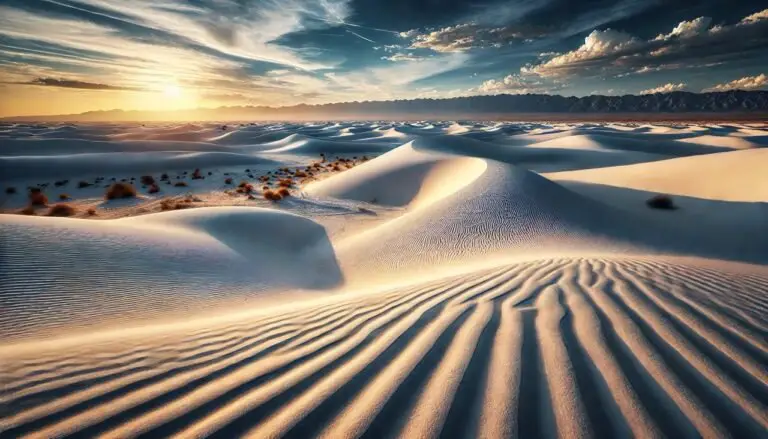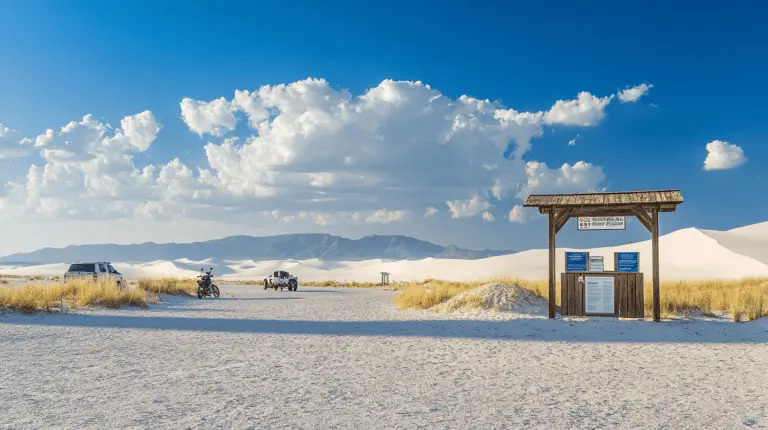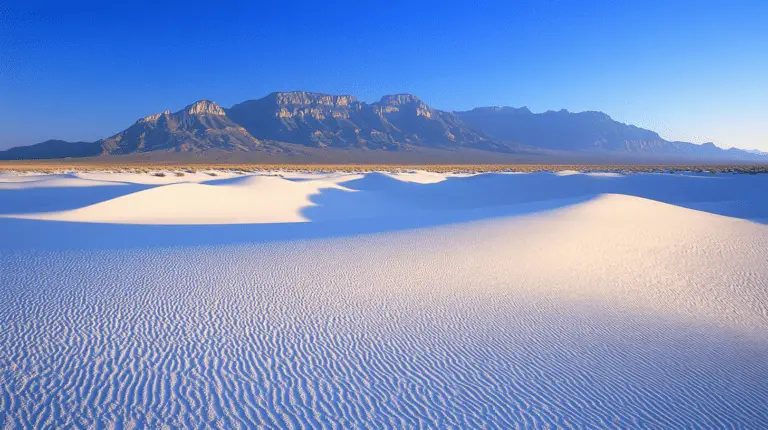Discovering White Sands National Park Plants
Biodiversity: No Snoozefest Here
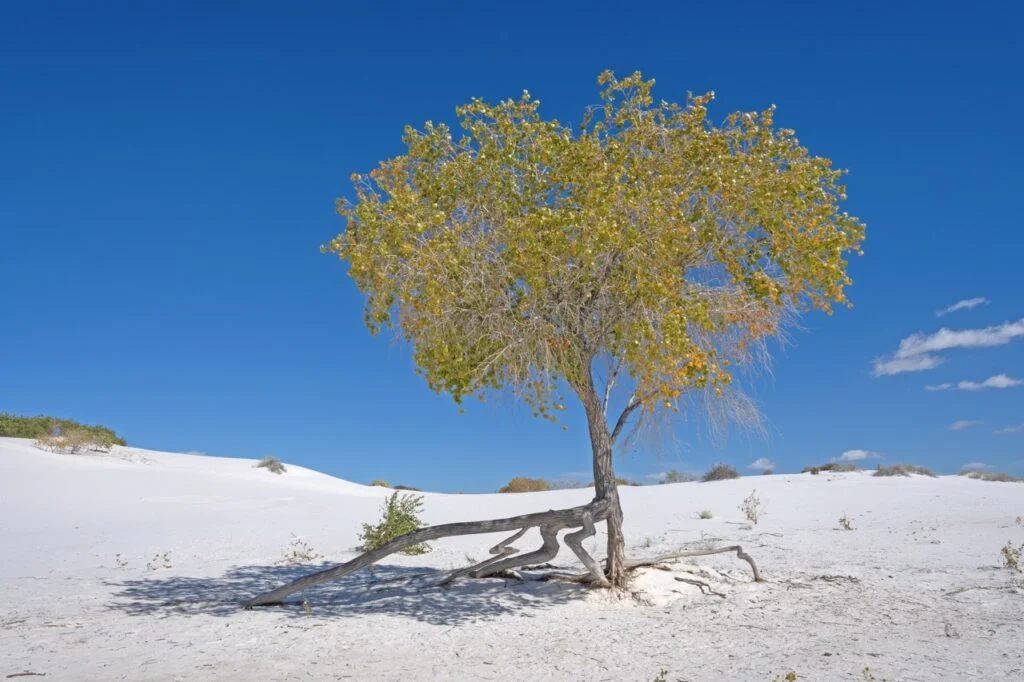
When you swing by White Sands National Park, you’re walking into a wonderland teeming with over 800 types of critters and loads of quirky plants. These aren’t your ordinary backyard varieties; they’ve evolved to survive the scorching summers and freezing winters of this desert.
| Type of Species | Count |
|---|---|
| Animals | 800+ |
| Plants | Lots and Lots! |
You might think of a desert as barren, but the plants here actually keep the show running. From anchoring the shifting sands to serving up breakfast and shelter for wildlife, every cactus and scrub plays its part. These plants are like the unsung heroes you never knew you needed.
The resilience of White Sands National Park plants allows them to thrive in conditions where few others could survive, making them integral to the park’s ecosystem.
Why This Ecosystem Matters
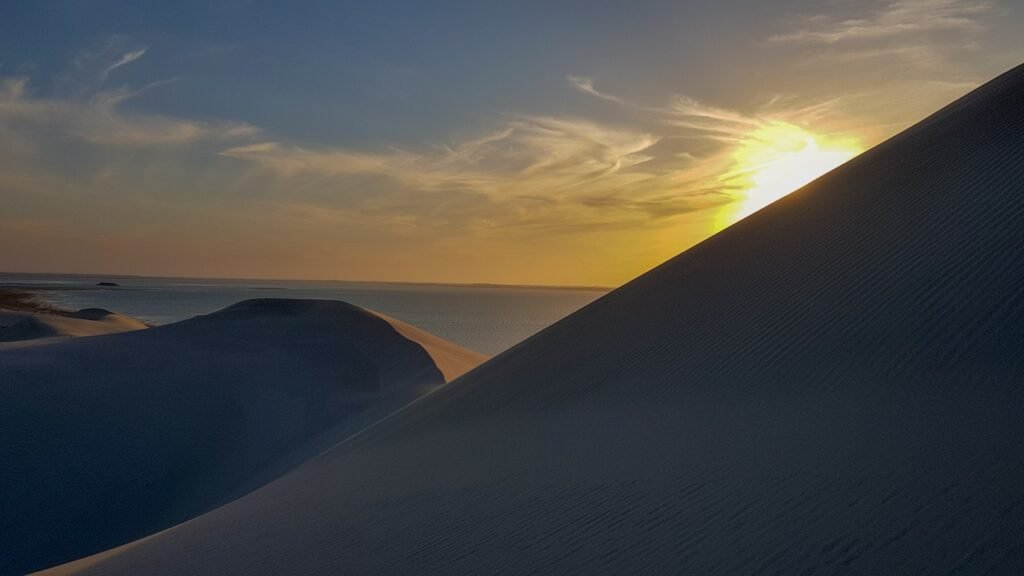
Ever wonder why anyone makes a fuss about the ecosystem in White Sands National Park? The critters and plants work in tandem to keep the place humming.
Here’s why it’s cool: The soil in White Sands isn’t just dirt; it’s the main course on the park’s menu. White Sands National Park plants have adapted to this unique soil, which plays a crucial role in maintaining the health and stability of the park’s shifting dunes.
The soil and plants have a buddy system going on that keeps dunes from blowing away and habitats ready for residents.
Picture this – plants growing in soil that can barely keep nutrients or keep its cool. We’re talking about soil that swings between bone-chilling cold and sizzling heat, and plants still manage to thrive. These green wonders anchor the food web and make sure the entire ecosystem can keep its balance.
Planning a trip to White Sands? Don’t miss checking out the plant life and dunes. You’ll leave with a newfound respect for how everything—right down to the tiniest grain of sand—affects the whole place. For the full scoop on what makes this desert a marvel, visit the National Park Service website.
Meet the Tough Plants of White Sands National Park

White Sands National Park plants are a testament to nature’s ability to adapt and thrive in extreme environments, making them a central part of the park’s biodiversity.
Step into White Sands National Park and you’ll see a tapestry of tough-as-nails plants adapting to one of Earth’s harshest places. Between the salty soil and scorching heat, these plants don’t just survive—they thrive in style.
How They’re Making It Work

Ever thought about growing in dirt with almost no food? The plants here have nailed it. With over 300 species showing off their survival skills, they’ve got the whole game figured out—from freezing winters to blazing hot summers.
The poster children for this grit are the cacti and succulents. They hang on through dry spells, storing up water like it’s going out of style. These champs know how to deal with both sweltering summers and chilly winters like it’s no big deal.
Tricks Up Their Sleeves
Plants here are like seasoned survivalists with a bag full of tricks:
- Water Hoarders: Cacti and succulents stash water in their tissues, busting out bright flowers come spring. They’re all about sharp spines and using minimal water. Perfect for a splash of color in the dunes.
- Soil Ninjas: Desert grasses, like alkali sacaton and Indian rice grass, laugh in the face of salty soil. They’re vital chow for critters like Apache pocket mice and kangaroo rats. Plus, these grasses have been useful to Native Americans for mat-making and tasty seeds.
- Temperature Survivors: When it comes to handling crazy temperature swings, plants like yuccas and purple sand verbena are the stars. From ice-cold nights to frying-hot days, they keep standing tall. These White Sands National Park plants not only endure these temperature swings but also help stabilize the delicate dune system.
Tough Plant Hall of Fame
| Plant Type | Super Skills |
|---|---|
| Cacti and Succulents | Water storage, low water needs, sharp spines |
| Desert Grasses | Salt tolerance, critter food, cultural uses |
| Soaptree Yuccas | Heat and cold tolerance, low water needs |
| Purple Sand Verbena | Temperature champion, salt smarts |
Appreciating these plant warriors and their inventive survival tactics adds a whole new level to your visit. Whether you’re wandering through the white dunes or tackling the trails, these plants are a testament to nature’s creativity and toughness.
Want the full scoop on these green gladiators? Check out our handy guide on White Sands’ plant life. And to plan your adventure, our park map is your GPS to all things awesome. Enjoy your trip!
Key Plant Species
Peeking into the plant life of White Sands National Park is like opening a treasure chest of surprises. These plants are tough cookies, perfectly suited for extreme conditions. You’ll come across the usual suspects – cacti and succulents – and the unsung heroes, desert grasses.
Cacti and Succulents
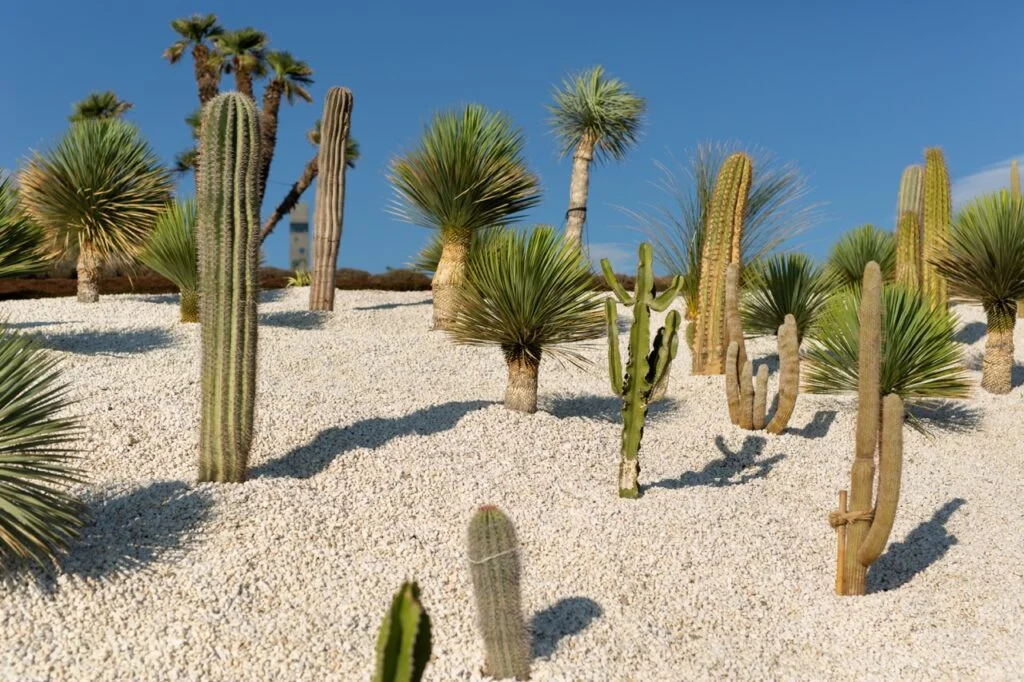
In the park, cacti and succulents stand out as rockstars. They don’t just survive; they flourish. Ever heard of the prickly pear or cholla? These guys store water for those never-ending hot summers and bone-dry winters. Come spring, they burst into color with vibrant blossoms, making the desert come alive. Meanwhile, the sharp spines are like nature’s ‘KEEP OUT’ signs for herbivores.
| Cacti and Succulents | Water Storage | Defense Mechanism | Notable Features |
|---|---|---|---|
| Prickly Pear | High | Sharp Spines | Spring Blossoms |
| Cholla | High | Sharp Spines | Spring Blossoms |
| Soaptree Yucca | Moderate | Fibrous Leaves | Tall Growth |
These plants are water-saving champs, needing just a tiny sip to keep going. White Sands National Park plants have evolved specialized mechanisms to survive with minimal water, making them an important study subject for scientists exploring drought resistance.
Desert Grasses
Desert grasses, like alkali sacaton and Indian rice grass, are the backbone of White Sands National Park. These grasses bravely face the highly alkaline soils and stand tall. They hold the dunes together and feed various critters, from the cute Apache pocket mouse to the hopping kangaroo rat.
White Sands National Park plants also provide essential shelter and nesting materials for these animals, further showcasing their importance in the park’s food chain.
| Desert Grasses | Soil Tolerance | Primary Consumers | Human Use |
|---|---|---|---|
| Alkali Sacaton | High Alkaline | Apache Pocket Mouse, Kangaroo Rat | Weaving Mats |
| Indian Rice Grass | High Alkaline | Rodents | Edible Seeds |
These grasses are VIPs for the park’s wildlife, stocking their underground storage with nutritious seeds. Native Americans used the sturdy blades for weaving and harvested the seeds for food (NPS).
Knowing these resilient plants gives you mad respect for the unique flora of White Sands National Park. White Sands National Park plants offer a fascinating glimpse into how life can adapt to even the harshest desert conditions, making every visit to the park a learning experience. Whether you’re trekking the white sands hiking trails or checking out other spots, you’ll definitely see the desert in a whole new light.
Surviving White Sands: The Incredible Plant Adaptations
The plants at White Sands National Park are like the superheroes of flora, thriving in conditions that would make lesser plants wilt. Let’s dive into their survival secrets and understand how these hardy greens manage to live in such a tough neighborhood.
Clever Ways of Storing Water
Water at White Sands is as rare as seeing a rainstorm in the desert—because, well, it is the desert. The scarcity of water shapes the characteristics of White Sands National Park plants, which have become masters at hoarding moisture in their roots and stems. To handle this dry spell, plants have turned into masters of water storage. Many, like cacti and succulents, stockpile water in their plump parts, buying themselves precious time during droughts.
Here’s how they do it:
- Plump Stems: Cacti, for instance, stash water in their thick stems.
- Tiny or No Leaves: To avoid losing water, some plants shrink or skip leaves entirely.
- Waxy Coating: A slick, waxy layer on their stems and leaves keeps the moisture locked in.
Check out some typical plants and their water tricks:
| Plant Species | Water Storage Method |
|---|---|
| Cacti | Water packed in stems |
| Yucca | Thick, fibrous leaves |
| Succulents | Plump, juicy tissues |
Want to learn more about how these desert champions deal with the heat? Hop over to our detailed piece on White Sands National Park Plants.
Battling Alkaline Soil
The soil at White Sands isn’t just dry—it’s nutrient-starved and highly alkaline. Only the toughest plants thrive here, like some gritty members of the Chihuahuan Desert (NPS). White Sands National Park plants, especially those native to the Chihuahuan Desert, have adapted to these challenging soil conditions, contributing to the park’s unique landscape.
Soil Survival Tactics
- Alkali Sacaton Grass: This grass eats high alkali soils for breakfast, serving as a snack for critters like Apache pocket mice and kangaroo rats (NPS).
- Indian Rice Grass: Handles salty soils like a champ and offers protein-rich kernels that wildlife love.
These skills keep these plants going strong:
| Plant Species | Soil Toughness |
|---|---|
| Alkali Sacaton Grass | Loves alkaline |
| Indian Rice Grass | Salt buster |
| Soaptree Yucca | Thrives in poor soil |
Plants keep the White Sands ecosystem ticking. Want to dig deeper? Check out our section on Ecosystem Importance.
There’s more to these incredible plant adaptations—explore the complete guide on the fascinating floras of White Sands National Park at white sands national park plants.
Conservation Efforts
Joining us at White Sands National Park means you’re part of an effort to protect some pretty tough plants that call this place home. Let’s chat about what’s being done to keep these flora thriving:
Keeping the Flora Flourishing
Surviving at White Sands isn’t a walk in the park—think nutrient-poor soils and wild temperature swings. Only the toughest plants from the Chihuahuan Desert can handle it here. Here’s how we’re helping them out:
- No Off-Roading: Sorry, thrill-seekers. Going off-road isn’t just bad for your tires; it squishes the soil and ruins plant roots. Stick to the paths and save the plants. Check out the rules for white sands national park off-roading.
- Caring for Soil Crusts: The crusty stuff under your feet? It’s not just dirt. It’s full of tiny living things like cyanobacteria and fungi that keep the soil stable and rich. We’re keeping feet and tires off to help plants grow.
- Controlled Burns: Fire isn’t always destructive. Sometimes, we use controlled fires to kick out pesky invasive species and give the native flora a fresh start.
- Watchful Eyes: Regular checks on plant health, numbers, and how they’re coping help us make smart decisions about their care.
| Measure | Why It’s Good |
|---|---|
| Off-Roading Ban | Prevents soil and root damage |
| Soil Crust Care | Stabilizes soil, boosts nutrients |
| Controlled Burns | Tackles invasives, renews plants |
| Monitoring | Guides effective protection |
Boosting Ecosystem Health
Healthy plants mean a healthy park. Here’s how we’re keeping the whole place in tip-top shape:
- Better Soil: Remember those soil crusts? They’re magic for the dirt, making it more fertile and better at holding water.
- Habitat Repair: Fixing up damaged spots by planting native species helps everything from bugs to birds feel at home. Curious about the critters? Check out white sands national park animals.
- Teaching the Public: We can’t do it alone. Sharing the why and how of our conservation efforts with visitors like you means more help and less harm. Join a white sands national park tour to learn with us.
- Handling Climate Change: Weather’s getting weird, and it’s messing with the plants. By tackling climate issues, we’re securing a future for these unique species. See how climate impacts us at white sands national park weather.
| Initiative | How It Helps |
|---|---|
| Soil Care | Keeps soil stable, nourished |
| Restoring Habitats | Supports wildlife, balances ecosystem |
| Educating Visitors | Encourages responsible actions |
| Fighting Climate Change | Protects long-term plant health |
By coming here, you’re already making a difference. Enjoy your time, soak in the beauty, and help keep White Sands thriving for the future.
Your visit helps support the conservation of White Sands National Park plants, which are vital to preserving the beauty and biodiversity of this remarkable desert ecosystem.
Challenges and Solutions
The Heat’s Toll on Plants
At White Sands National Park, the plants are tough but they face some stiff challenges thanks to the harsh climate. The park’s famous for its unique wet dune system that thrives on moisture. Climate shifts and droughts throw a wrench in this delicate balance, messing with the park’s ecosystem (NPS). Plants like cacti, yuccas, soaptree yucca, and desert grasses have adapted to the extreme heat, paltry rainfall, and alkaline soil. But they aren’t invincible against climate change (Wikipedia).
| Bummer | Trouble for Plants |
|---|---|
| Scorching Heat | Burns and stress |
| Drizzle | Water’s low, plants suffer |
| Alkaline Soil | Hard to grab nutrients |
| Long Droughts | Sucks away moisture |
Plants aren’t just scenery—they hold the dunes together and give critters both food and shelter (NPS – Nature & Science). Knowing this stuff can make your visit to White Sands more meaningful and help you appreciate its plant life.
Fighting Back with Green Practices
To keep White Sands’ plants alive and kicking, they’ve put smart strategies in place. These steps are about more than saving plants—they’re about keeping the whole park vibing for years to come.
Saving the Greens:
- Keeping Tabs: They keep a close watch on the plants and dunes to catch any climate-related hiccups early (NPS).
- Replanting Drives: Replanting native species helps rebuild plant populations and keeps the dunes sturdy (Wikipedia).
Boosting Ecosystem Health:
- Smart Water Use: They’ve got water-saving tricks to help plants survive dry spells.
- Soil TLC: Managing the soil’s alkaline nature makes it easier for plants to soak up nutrients.
Want to pitch in? Here’s how you can help protect White Sands while you explore. Check out our info on park rules and tips.
By getting what makes these plants tick and backing eco-friendly measures, you play a part in keeping White Sands’ flora thriving. So go ahead, visit and marvel at the green wonders of White Sands National Park.
Latest Updates and News
White Sands National Park continues to be a fascinating destination for plant enthusiasts and researchers alike. Recent studies and conservation efforts have shed new light on the unique flora that thrives in this gypsum dune ecosystem.
Adaptive Plant Research
Scientists have made significant progress in understanding the adaptive mechanisms of White Sands National Park plants. New research has revealed how certain species, such as the White Sands fanmustard, have evolved to thrive in the harsh, alkaline environment of the gypsum dunes. These findings are crucial for conservation efforts and provide insights into plant adaptation to extreme environments.
Biodiversity Monitoring
The park has implemented an advanced biodiversity monitoring program, focusing on the diverse plant species found within its boundaries. This initiative aims to track changes in plant populations and distribution, helping park managers make informed decisions about conservation strategies. Visitors can now participate in citizen science projects, contributing to the ongoing study of White Sands National Park plants.
Restoration Projects
White Sands National Park has launched several habitat restoration projects to protect and enhance native plant communities. These efforts include removing invasive species and reintroducing native White Sands National Park plants to areas affected by human activity. The park’s commitment to preserving its unique flora ensures that future generations can experience the remarkable plant life of this desert ecosystem.
Educational Initiatives
To raise awareness about the importance of White Sands National Park plants, the park has developed new educational programs and interpretive materials. Visitors can now access detailed information about plant survival strategies, including adaptations to drought, heat, and high soil alkalinity. These resources highlight the resilience and diversity of the park’s flora, from hardy grasses to specialized succulents.
Sustainability Efforts
The park has intensified its focus on sustainability, implementing measures to reduce the environmental impact of tourism on White Sands National Park plants. These initiatives include water conservation practices and the use of native plants in landscaping around park facilities. By setting an example of responsible environmental stewardship, the park aims to inspire visitors to consider their own impact on natural ecosystems.


